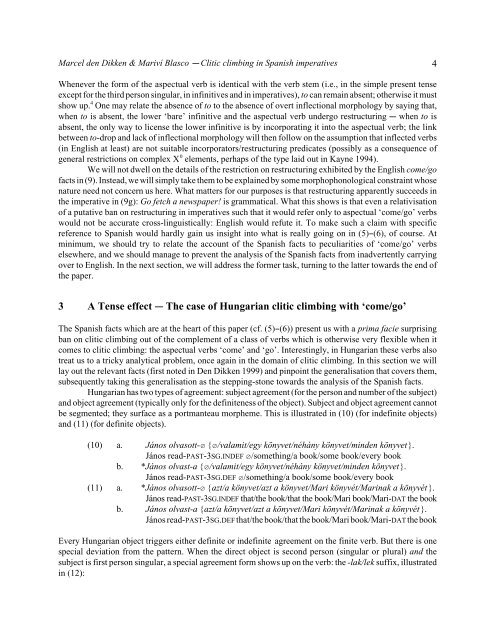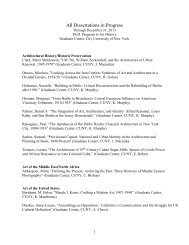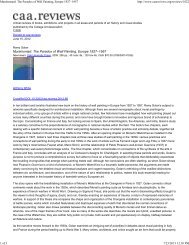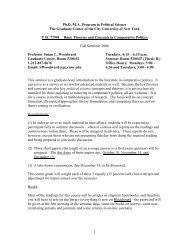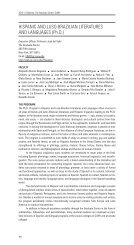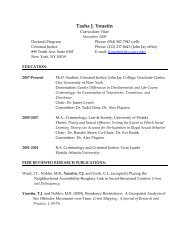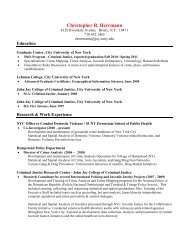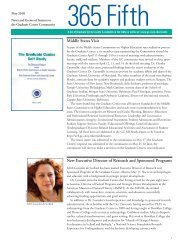Clitic climbing in Spanish imperatives - CUNY Graduate Center
Clitic climbing in Spanish imperatives - CUNY Graduate Center
Clitic climbing in Spanish imperatives - CUNY Graduate Center
Create successful ePaper yourself
Turn your PDF publications into a flip-book with our unique Google optimized e-Paper software.
Marcel den Dikken & Mariví Blasco & <strong>Clitic</strong> <strong>climb<strong>in</strong>g</strong> <strong>in</strong> <strong>Spanish</strong> <strong>imperatives</strong><br />
Whenever the form of the aspectual verb is identical with the verb stem (i.e., <strong>in</strong> the simple present tense<br />
except for the third person s<strong>in</strong>gular, <strong>in</strong> <strong>in</strong>f<strong>in</strong>itives and <strong>in</strong> <strong>imperatives</strong>), to can rema<strong>in</strong> absent; otherwise it must<br />
show up. 4 One may relate the absence of to to the absence of overt <strong>in</strong>flectional morphology by say<strong>in</strong>g that,<br />
when to is absent, the lower ‘bare’ <strong>in</strong>f<strong>in</strong>itive and the aspectual verb undergo restructur<strong>in</strong>g & when to is<br />
absent, the only way to license the lower <strong>in</strong>f<strong>in</strong>itive is by <strong>in</strong>corporat<strong>in</strong>g it <strong>in</strong>to the aspectual verb; the l<strong>in</strong>k<br />
between to-drop and lack of <strong>in</strong>flectional morphology will then follow on the assumption that <strong>in</strong>flected verbs<br />
(<strong>in</strong> English at least) are not suitable <strong>in</strong>corporators/restructur<strong>in</strong>g predicates (possibly as a consequence of<br />
general restrictions on complex X 0 elements, perhaps of the type laid out <strong>in</strong> Kayne 1994).<br />
We will not dwell on the details of the restriction on restructur<strong>in</strong>g exhibited by the English come/go<br />
facts <strong>in</strong> (9). Instead, we will simply take them to be expla<strong>in</strong>ed by some morphophonological constra<strong>in</strong>t whose<br />
nature need not concern us here. What matters for our purposes is that restructur<strong>in</strong>g apparently succeeds <strong>in</strong><br />
the imperative <strong>in</strong> (9g): Go fetch a newspaper! is grammatical. What this shows is that even a relativisation<br />
of a putative ban on restructur<strong>in</strong>g <strong>in</strong> <strong>imperatives</strong> such that it would refer only to aspectual ‘come/go’ verbs<br />
would not be accurate cross-l<strong>in</strong>guistically: English would refute it. To make such a claim with specific<br />
reference to <strong>Spanish</strong> would hardly ga<strong>in</strong> us <strong>in</strong>sight <strong>in</strong>to what is really go<strong>in</strong>g on <strong>in</strong> (5)%(6), of course. At<br />
m<strong>in</strong>imum, we should try to relate the account of the <strong>Spanish</strong> facts to peculiarities of ‘come/go’ verbs<br />
elsewhere, and we should manage to prevent the analysis of the <strong>Spanish</strong> facts from <strong>in</strong>advertently carry<strong>in</strong>g<br />
over to English. In the next section, we will address the former task, turn<strong>in</strong>g to the latter towards the end of<br />
the paper.<br />
3 A Tense effect & The case of Hungarian clitic <strong>climb<strong>in</strong>g</strong> with ‘come/go’<br />
The <strong>Spanish</strong> facts which are at the heart of this paper (cf. (5)%(6)) present us with a prima facie surpris<strong>in</strong>g<br />
ban on clitic <strong>climb<strong>in</strong>g</strong> out of the complement of a class of verbs which is otherwise very flexible when it<br />
comes to clitic <strong>climb<strong>in</strong>g</strong>: the aspectual verbs ‘come’ and ‘go’. Interest<strong>in</strong>gly, <strong>in</strong> Hungarian these verbs also<br />
treat us to a tricky analytical problem, once aga<strong>in</strong> <strong>in</strong> the doma<strong>in</strong> of clitic <strong>climb<strong>in</strong>g</strong>. In this section we will<br />
lay out the relevant facts (first noted <strong>in</strong> Den Dikken 1999) and p<strong>in</strong>po<strong>in</strong>t the generalisation that covers them,<br />
subsequently tak<strong>in</strong>g this generalisation as the stepp<strong>in</strong>g-stone towards the analysis of the <strong>Spanish</strong> facts.<br />
Hungarian has two types of agreement: subject agreement (for the person and number of the subject)<br />
and object agreement (typically only for the def<strong>in</strong>iteness of the object). Subject and object agreement cannot<br />
be segmented; they surface as a portmanteau morpheme. This is illustrated <strong>in</strong> (10) (for <strong>in</strong>def<strong>in</strong>ite objects)<br />
and (11) (for def<strong>in</strong>ite objects).<br />
(10) a. János olvasott-i {i/valamit/egy könyvet/néhány könyvet/m<strong>in</strong>den könyvet}.<br />
János read-PAST-3SG.INDEF i/someth<strong>in</strong>g/a book/some book/every book<br />
b. *János olvast-a {i/valamit/egy könyvet/néhány könyvet/m<strong>in</strong>den könyvet}.<br />
János read-PAST-3SG.DEF i/someth<strong>in</strong>g/a book/some book/every book<br />
(11) a. *János olvasott-i {azt/a könyvet/azt a könyvet/Mari könyvét/Mar<strong>in</strong>ak a könyvét}.<br />
János read-PAST-3SG.INDEF that/the book/that the book/Mari book/Mari-DAT the book<br />
b. János olvast-a {azt/a könyvet/azt a könyvet/Mari könyvét/Mar<strong>in</strong>ak a könyvét}.<br />
János read-PAST-3SG.DEF that/the book/that the book/Mari book/Mari-DAT the book<br />
Every Hungarian object triggers either def<strong>in</strong>ite or <strong>in</strong>def<strong>in</strong>ite agreement on the f<strong>in</strong>ite verb. But there is one<br />
special deviation from the pattern. When the direct object is second person (s<strong>in</strong>gular or plural) and the<br />
subject is first person s<strong>in</strong>gular, a special agreement form shows up on the verb: the -lak/lek suffix, illustrated<br />
<strong>in</strong> (12):<br />
4


